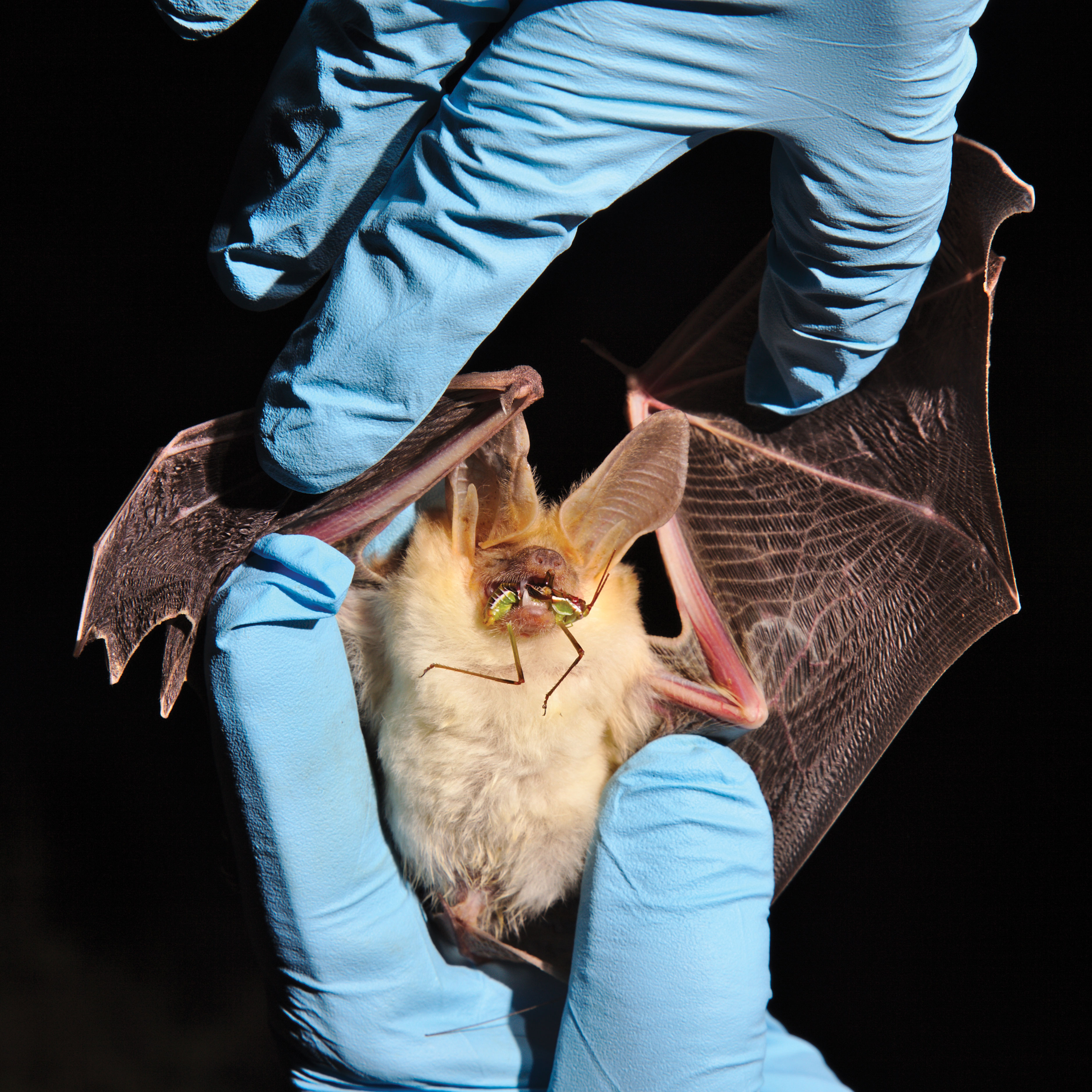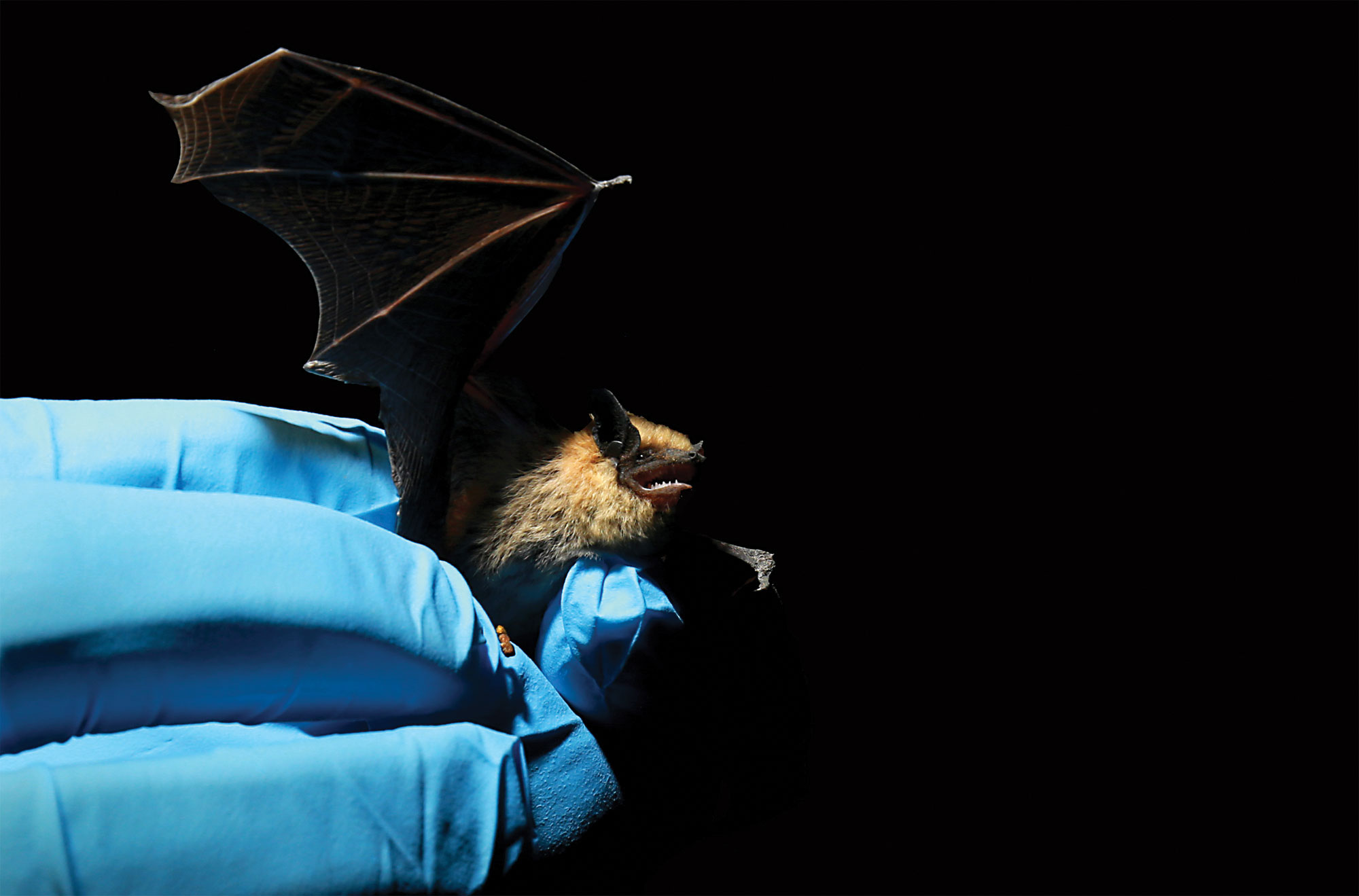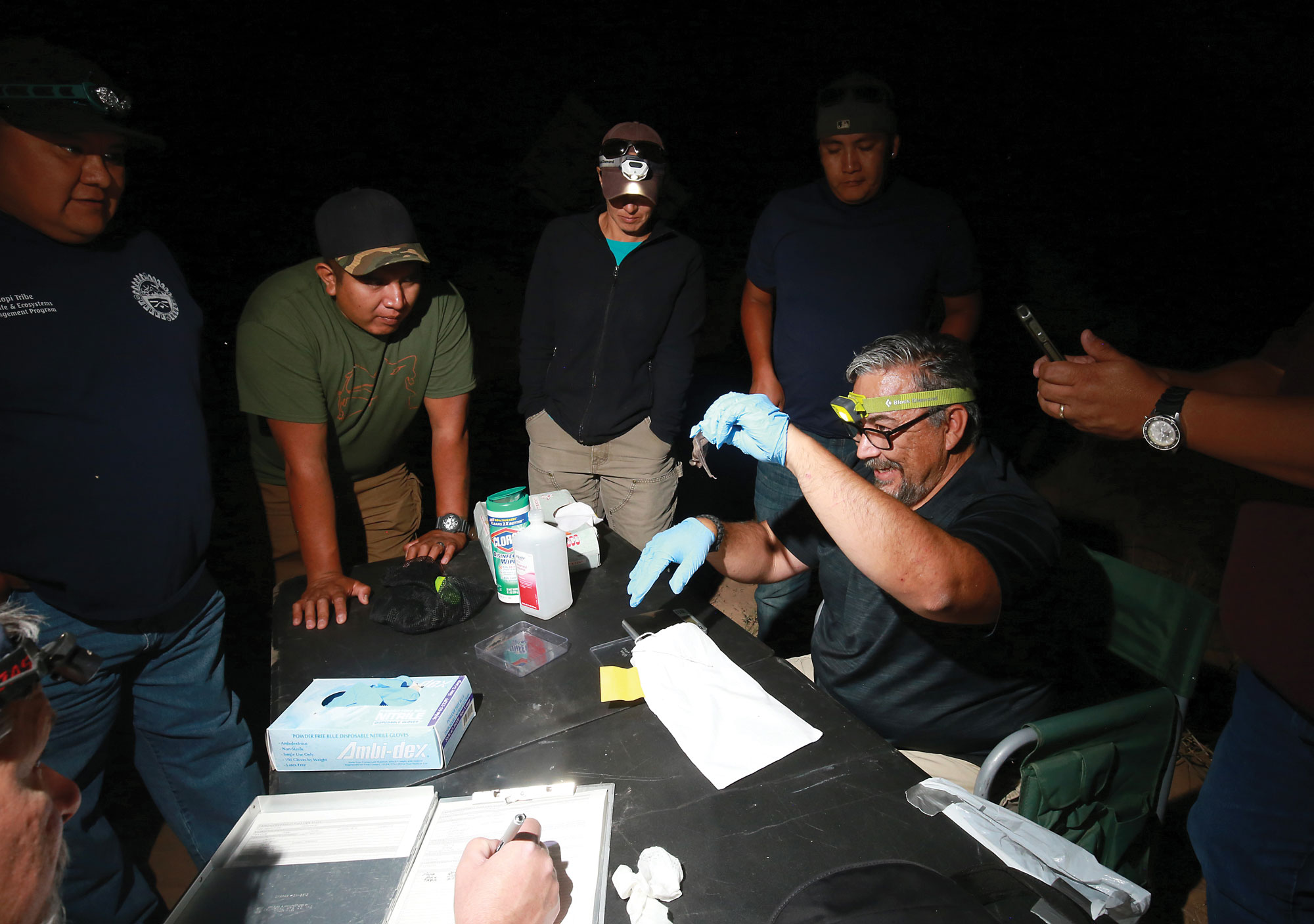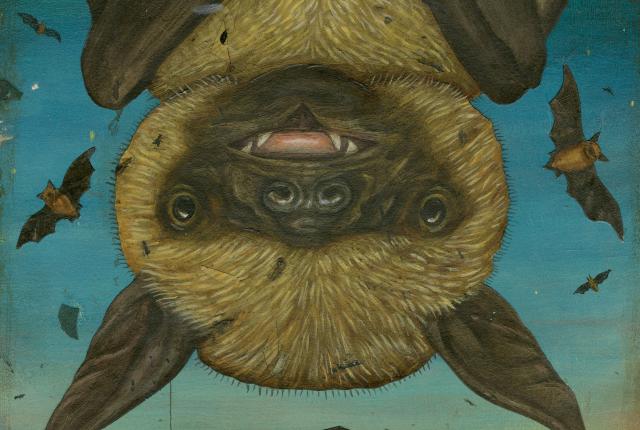Above: Because bats hang out in colonies, live in dark areas, are active at night, and are very fast fliers, they are still shrouded in mystery. Illustration by Jason Holley.
A BAND OF GORGEOUS teal-colored sky hovers between the radiant yellow of the setting sun and the oncoming deep blue of night as I await the evening exodus of all the bats inside Carlsbad Caverns. It is my first visit to the southeastern New Mexico national park, but not my first time ever seeing bats. I grew up watching them dart under and over our neighborhood streetlights in Crownpoint and flutter in and out of the stadium lights at every summer rodeo.
This evening, I’ve joined a couple dozen tourists in an outdoor amphitheater at the mouth of the main cave. We wait for Mexican free-tailed bats to make their appearance while a park ranger tells bat origin stories based on those from indigenous people of an unnamed tribe, debunks bat myths, and lists bat facts, his voice amplified by a PA system camouflaged among the cave rocks.
As the lights of the city of Carlsbad twinkle in the distance, the ranger becomes quiet. He turns away and peers down into the cave. A couple of tourists point hopefully at flapping things in the sky, but those are just cave swallows—the birds that hang out at the mouth of the cave all day, the ones visitors mistake for bats all the time, and the ones that give that part of the cave a certain funky aroma.
“They look like the Batman signal come to life,” says the ranger on the microphone, telling us what to watch for. He reminds us to be quiet, tells a kid to turn off his phone, then lets us sit in silence for a bit.
Silence and a dark-blue sky. It’s nice. Peaceful.
Then someone on the far side of the amphitheater gasps. Four or maybe 50 bats flutter over our heads. It’s hard to say. They zoom. In the dim light, I can’t see the little mammals until they break over the horizon. With the sky as a backdrop, I witness the sharp angles of their wings. It’s true, they look kind of like the Bat-Signal come to life, but I’d go a bit further to say they look more like the Batman Beyond symbol: a simpler V shape with fewer angles, because that’s really all my eyes can truly grasp.
Within minutes, hundreds of bats take over the sky around us. Their tiny leathery wings don’t make a sound, but the bats click and squeak, building an audio profile of us and our surroundings using echolocation. Although their vision is notoriously limited, they know exactly where we are, even as we squint to see them.
At full capacity, 300,000 to 400,000 Mexican free-tailed bats live in the depths of the cave. Another 1,000 or so cave myotis bats and 1,000 of the fringed myotis species live even deeper in the cave, a place called Lake of the Clouds, more than 1,000 feet below the cave’s mouth. Because these bats are so hidden, you’re unlikely to see even one hanging from the ceiling on a Carlsbad Caverns tour.
To me, bats are fascinating and cute. I once made a bat-shaped children’s book for a high school craft assignment. It was called “Little Bat,” and it was about a tiny bat being bullied because he’s small and weird-looking. In the end, he finally finds a friend in a kind vampire.

Above: Antrozous pallidus don't deserve their bad rap. Photograph by Kenneth Ingham.
Bats don’t deserve their bad rap as supposed flying rodents. They’re not fully understood by most people or even biologists. Which is one reason they’re in danger of succumbing to a deadly disease called white-nose syndrome that has already swept across much of the eastern United States and now lurks at the doorstep of New Mexico.
MANY OF THE BATS I SEE LEAVING THE CAVE on this night are pregnant females returning from their winter roosts in Mexico, ready to give birth in Carlsbad Caverns in mid-June. Newly born pups form a unique bond with their mothers. While they keep to the “nursery,” a spot in the cave where all the pups hang together, their mothers swoop by, picking them out by sound and smell to nurse several times a day for about two months.
Then, one day, without flying lessons or an instruction manual, “they just let go of the cave ceiling and hope for the best,” says Ellen Trautner, a physical science technician at Carlsbad Caverns National Park.
Because bats hang out in colonies (which can number from just a few to a few million), live in dark areas, are active at night, and are very fast fliers, they are still shrouded in mystery.
“How do they know exactly when sunset is?” Trautner says. “Where precisely do they migrate to?” She doesn’t know. Technology doesn’t allow for bats to be tagged or radio-tracked.
She and other biologists need answers fast. White-nose syndrome, caused by the fungus Pseudogymnoascus destructans, was first detected in New York in 2007. The disease has now spread to 33 states and crept as far west as Texas and Oklahoma, and now even California. Microscopic evidence of it has already been found in Carlsbad Caverns and El Malpais National Monument.
Five and a half million bats have perished. The species most affected by the disease, the little brown bat, is now a poster child of its ravages. The bat looks exactly like its name—small and brown, with long, pointy ears and shiny fur fit for a shampoo commercial.
The disease thrives in the cold-storage conditions of cave hibernation, growing on the tips of bat noses and over their wings as they sleep. It causes the bats to rouse from their roosts in the middle of winter—sometimes causing them to fly right out into the snow—and the commotion means they burn up energy and fat reserves, become malnourished, and eventually die. “I started hearing about white-nose syndrome in 2010,” Trautner says. “That’s when a lot of caves started closing to the public, including some of our caves out here, even though it was still thousands of miles to the east of us. A lot of our caves are either known bat hibernaculum sites or known maternity colonies.”
But you can’t close Carlsbad Caverns National Park to the half million visitors who come every year. Instead, rangers will soon enforce a new protocol wherein visitors will be asked about other caves they’ve visited and required to decontaminate themselves when touring the off-trail Spider Canyon and Slaughter Canyon caves, where they come in close proximity to the animals.

Above: At Carlsbad Caverns, researchers such as Andreas Pflitsch prove that bats don't deserve their bad rap. Photograph by Kenneth Ingham.
“We’ve done a few dry runs, but we’re actually going to soon do something similar to what Mammoth Cave, in Kentucky, does and have walk-over mats that people can just walk on. They’re filled with a real light cleaning solution that disinfects the bottoms of their shoes,” Trautner says. “We’re actually going to do it as they leave the cave, not as they go in, so that they’ll be ‘deconned’ [decontaminated] for future caves.”
As for de-conning before entering a cave, the park doesn’t want to introduce cleaning products into them, so it asks visitors not to wear shoes that have been worn in other caves. Cavers, the folks who have specialized “spelunking” gear for squeezing deep inside, are on board with the process, Trautner says. But “for all the work we do, like de-conning people’s shoes and cleaning cameras and all this other gear, we do think that the primary way of white-nose syndrome spreading is by the bats themselves.” The Mexican free-tailed bats at Carlsbad Caverns and other New Mexico species migrate and travel long distances to other caves throughout the state, as well as to Mexico and even South America.
Representatives from state and federal land management agencies (the National Park Service, Bureau of Land Management, U.S. Forest Service, and New Mexico State Parks) meet regularly to develop unified responses to white-nose syndrome, Trautner says.
At Pecos National Historical Park, scientists want to establish some baseline facts about bats. “We’re in a quick trip to capture ecological information on where bats are at,” says Ernest Valdez, a bat biologist working in the park on basic bat questions. “What species are there? Are they migratory? Do they hibernate? What kind of food insects are they eating?”
The answers to those questions can help scientists anticipate what would happen if bats in New Mexico get white-nose syndrome. “We really don’t have an assessment on population levels or total number of individuals,” Valdez says. “Part of that reason is we have such a wide array of landscape for bats to use.”
New Mexico is a permanent home and a summer roost for 29 species of Chiroptera—fully half of the country’s bat species. And that makes New Mexico a pretty great place to do bat research, even if our diffuse landscapes and caving sites make it that much harder to track bats.
When white-nose syndrome swept through the East, biologists could monitor population declines, because those bats concentrate themselves in caves with easier access. That clustered lifestyle also helped the disease devastate them. Here’s the potentially good news, Valdez says: For all of the paranoia around white-nose syndrome coming to New Mexico, it might actually strengthen bat species—at least in the long run.
Look at what happened in Europe, he says, where white-nose syndrome originated. The disease devastated bat populations there, but eventually some bats developed immunities. Sooner or later, the fungus will manifest into full-blown white-nose syndrome here. “The bats that aren’t going to make it,” Valdez says, “those genes are going to be lost. And the ones that do make it, they’ll make it through the bottleneck. I think that’s what’s happening here. We’re watching this biological, evolutionary process where animals are getting selected out of the ecosystem, and those that survive will prosper and be able to thrive even in sessions of white-nose syndrome.”

Above: Lawrence Abeita steadies a bat net at a pond on Santa Ana Pueblo. Photograph by Andi Murphy.
LAST YEAR, VALDEZ GAVE PRESENTATIONS AT THE FIRST Southwest Native American Workshop on Bats, in Albuquerque. The Bureau of Indian Affairs hosted more than a dozen tribal biologists, natural resource managers, and tribal representatives from all over New Mexico and Arizona. Valdez was one of a handful of biologists and researchers who talked about white-nose syndrome, audio research methods, and safe bat-netting methods.
I was also there, with a media badge and a bag of equipment to record interviews for my Toasted Sister podcast, a show I host about Native food. I included one episode on the importance of bats to Native people.
“There isn’t enough biological and cultural information on bats in tribal lands,” said Lawrence Abeita, who organized the bat gathering to inform tribal people about white-nose syndrome and to boost awareness of how important bats are in Native land, culture, and language. A wildlife biologist for the Bureau of Indian Affairs, Abeita, who hails from Isleta Pueblo, had an epiphany one day, he said, when he couldn’t remember the Tiwa word for “bat.” He had to ask the elders of his pueblo.
Read more: New laser technology reveals tantalizing secrets about everyone’s favorite cave.
It’s Naca chledeh. It translates roughly to “moonlight flying skin,” he said.
Every other tribal person there talked about what bats mean to their culture. A few told bat origin stories. Timothy Smith, of the Mescalero Apache tribe, relayed this one: Bats were claimed by the night and so they became a night animal. They’re important to Apache people because they went deep into the ground and pulled the yucca plant up and helped it grow. This was a beautiful flower, and the bats loved it and took great care of it. One day, a lightning storm came and the bats left their yucca and hid in the trees. They didn’t know their pretty yucca plant had been struck by lightning and turned into what it looks like today: a spiky, odd-looking plant with less beautiful flowers. The bats called for their yucca with the beautiful flowers and couldn’t find it. They’re still calling for it today.
One workshop covered how outside biologists and land management agencies can better consult with tribes that already function as their own land management agencies. While the tribal representatives agreed that bats need to be studied, past experiences with nontribal scientists have warranted mistrust. Relationships, meaningful consultation, and permission need to happen first.
After talking with Santa Ana Pueblo, Valdez and two dozen other participants, including me, were granted permission to do some bat netting by a pond where the bats like to drink water. About 40 feet in diameter, it was originally built for cattle. We spread around it as the sun slipped away.
A thin net, which disappeared against the dark water, unfurled across the length of the pond, between two lightweight poles staked into the ground. We waited. With quiet voices, Valdez and other biologists exchanged bat facts and bat-netting stories. Lawrence and other tribal representatives asked bat questions and talked about their land and their work as conservationists.
“Bat!” someone yelled.
The net was reeled in, and one of the biologists, wearing gloves, untangled a tiny, furry creature. It squeaked and wriggled around as we crowded in to see. This was my first time seeing a bat up close, and it was a lot smaller than I had imagined. Its head was barely as big as the biologist’s thumbnail; its wings may have stretched the length of his hand.

Above: The smallest bat species, a canyon bat. Photograph by Andi Murphy.
The canyon bat, or western pipistrelle, was handed to Valdez, who’d set up a table with a small scale. “This is the smallest bat species in the U.S.,” Valdez said, “just 5.8 grams.”
A nickel weighs 5 grams. That’s a tiny creature. But as insect-eating beasts, even the tiniest bats have a huge job. A bat can eat half its own body weight in insects in one night. Debbie Buecher, a Tucson-based bat biologist who studies bat cave microclimates, did some quick field math to show how white-nose syndrome affects an entire biological picture.
“Five and a half million [bats] are dead now from white-nose syndrome,” she said. Those bats were once active for up to 145 nights a year. That adds up to more than 2,000 tons of insects that would have gone into the tiny bellies of bats. To put it into perspective, Buecher compared it to the weight of 400 elephants’ worth of insects that would have otherwise been eaten.
IN HER WORK IN NEW MEXICO AND ARIZONA, Buecher observes bats, sometimes netting them outside and sometimes going into their caves, to check for white-nose syndrome. She also looks at which caves might have optimal climates for harboring the fungus and gives that information to agencies like BLM and the Park Service. Bats in El Malpais National Monument, Fort Stanton Caves, and Carlsbad Caverns are white-nose-syndrome free, she says.
Buecher and her friend Maggie, a western mastiff bat with a 22-inch wingspan, also go around to parks to educate the public about bats. (Western mastiffs are the largest bats in North America.)
“People look at bats and think they’re kind of dirty flying mice,” Buecher says. “When I do public outreach, they’re always amazed what I can present about what we know about bats.”
A big reason for the misunderstanding has to do with horror movies. Bats are always monsters in fantastic pieces of Hollywood cheese, like the Dracula movies, where they turn into vampires. Or there’s Bats, in which genetically manipulated bats attack and kill people in Texas, and the 1979 thriller Nightwing, where (fake) bats terrorize an Indian reservation in Arizona.
“That’s usually what I’m fighting against when I do education in schools,” Buecher says.
While vampire bats are a thing—they live on blood and range from Mexico to South America—none reside in the U.S. (and none turn into human vampires). Most bats don’t have rabies, either, according to the Centers for Disease Control and Prevention. And bats don’t want to fly into your hair. If you get close to roosting bats, it may look as though they’re diving for your head, but they’re not. They drop from the ceiling to take flight. It’s your head that’s in the way of the bats.

Above: Wildlife biologist Ernest Valdez displays a cave bat for attendees at the bat-netting workshop at Santa Ana Pueblo. Photograph by Andi Murphy.
Bats are intelligent and necessary, though scientists are still figuring out how much of a keystone species they are. Some bats feed on nectar and are important agave pollinators in New Mexico. Most eat tons of the insects that damage our crops and feast on our blood.
Learning more about bats, Buecher says, “makes us more sensitive, I think, to nature; more willing to do the things conservation requires if it means a sacrifice from us.”

GO CAVING
Carlsbad Caverns National Park’s Bat Flight Program runs from late May through October, after which bats migrate south for the winter. Gather at the amphitheater near the caverns’ Natural Entrance at 7:30 p.m. for the evening exodus. To see them fly out of the Bat Cave at El Malpais National Monument, near Grants, head to the El Calderon Area before sundown. On some Saturdays, a ranger guides a tour of the flight. During the summer, Ted Turner Reserves’ Armendaris Ranch offers a guided Bats and Brews tour, with craft beer from Truth or Consequences Brewing.
BAT FACTS
Echolocation: More than half of all bat species use echolocation to “see” the world. Bats emit sounds that bounce off of objects or prey like moths and beetles and back to their ears and brains, where a mental picture is formed. For example, they can determine how big an insect is and which way it’s moving to make an expertly calculated kill move. Like most bats, the Mexican free-tailed bat passes sounds through its larynx at frequencies that are only halfway audible to humans.
Pups: Baby bats, or “pups,” drink milk from a mother bat and live in a maternity colony until they are old enough to fly on their own.
Numbers: There are more than 1,300 species of bats in the world, ranging in size from flying foxes, which could have a wingspan of six feet, to the tiny Kitti’s hog-nosed bat, with a six-inch wingspan.
Predators: Bats are expert predators, but they’re not above getting eaten by other animals like owls, hawks, snakes, and raccoons. Hawks will sometimes dive-bomb into clusters of bats that are leaving their roost during the evening.
Lifespan: Mexican free-tailed bats can live 10 to 15 years. Other species can live 20 years.
Tequila: Bats are the main pollinators of agave, the plant used for tequila. Three out of the 29 species of bats in New Mexico are nectar-feeding bats.


